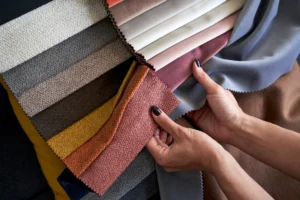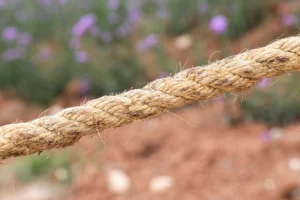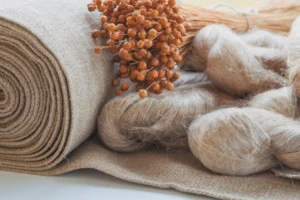linen and Flax are two words that identify textiles that generate a great deal of admiration and respect in the world of textiles. Though the words are used interchangeably in a common language, they are actually different in meaning, and one should understand the origin, processing, and usage that differentiate these terms.
Basically, flax refers to the plant Linum usitatissimum, from which the fibers are derived. The plant presents the characteristic of yielding both tough, hard-wearing textile fibers and nutritional edible seeds that are used in food and industry.
Linen is a manufactured textile that is extracted from flax fibers after being processed. To say the least, linen has the durability and natural glow of a shine.
In terms of sustainability, it is considered one of the most luxurious as well as ecologically friendly materials around today.
This article will explore the historical importance of flax, its processing into linen, and how the two terms are differentiated.
Historical Importance of Flax
Flax is one of the oldest domesticated plants whose history goes as far back as tens of thousands of years. Flax has archaeological evidence of usage dating back as far as 34,000 years when early humans of the region of present-day Georgia used flax fiber to make the first tools, ropes, or clothes.
Flax in Ancient Societies
Flax cultivation and usage were significant parts of ancient societies:
- Egypt: Flax was at the center of Egyptian culture because linen was a treasured textile for its quality and durability.
- Linen was the preferred fabric for clothing, sails, and burial shrouds. In fact, the Egyptians covered their mummies in fine linen to symbolize purity and ensure them a safe journey to the afterlife.
Egyptians even referred to linen as “woven moonlight” due to its luster and grace.
- Mesopotamia: In Mesopotamia, flax production was an important part of the economy. Linen clothes were the symbol of wealth and class; the cloth was expensive and time-consuming to manufacture.
- Europe: For the first time, linen was a major trading product within the Roman Empire. The Romans found linen useful in the hot weather for wearing tunics, underwear, and household items.
Medieval Europe During the Middle Ages, flax spread throughout European lands. Of course, cloth was the only garment made in linen, in addition to being used for rope, sacks, and even paper in this period where agriculture and text from flax had become elements of a rural means of living.
Flax Today

Mechanical improvements were incorporated in linen manufacturing, hence, more reachable for a wider population. Linen was thus one of the famous exports from the Irish land to be associated with good quality, so cities like Belfast have come to be called “Linenopolis”.
Today, flax remains a staple crop and linen is the world’s best crop that will last a lifetime for sustainability and timeless beauty.
The Flax Plant: Nature’s Versatile Gift
The hardy annual, or flax plant, Linum usitatissimum grows in temperate climates up to about 2–4 feet. Small, pale flowers form on the plant and generally are blue; however, certain varieties can present white or yellow blooms.
Significant Flax Features
- Flax Stems: The stems of flax are loaded with long, strong fibers. These fibers create linen’s desirable characteristics of strength and ruggedness.
- Seeds: Flaxseeds are rich in nutrients, essential omega-3 fatty acids, dietary fibers, and lignans. Health foods, supplementations, and oils from the crop are applied.
- Sustainable: the crop is an eco-friendly crop that uses less water and chemicals. Still, every part of the plant can be utilized; therefore, the crop generates zero waste.
How to Obtain Linen from Flax

It is time-consuming to develop raw flax fibers into the linen material. Several steps have been advanced through centuries. Traditional ways remain in use across the globe in some specific regions.
Stages of Production of Linen
- Plantation and Harvesting: Linen seeds are sown early in springtime. Flax stalks are brought up when yellowish color. The whole plant is pulled to retain the long length of flax fibers.
- Retting: Cut plants undergo retting which entails exposing the stems to moisture, thereby breaking down the pectin and holding the fibers together with the woody core. Retting can be done using dew, water, or chemicals.
- Breaking and Scutching: Once retting is over, the woody portions of the stem are broken, and fibers are separated through breaking and scutching.
- Heckling: The impurities are combed out, and the fibers are aligned to form smooth, silky strands using fine-toothed tools.
- Spinning and Weaving: Cleaned fibers are spun into yarn. The yarn is then woven to form linen fabric. This stage determines the final texture and appearance of the linen.
What’s special about linen?

Linen is hailed for combining in beauty and utility the singular value for beauty, as well as durability and strength. Unlike synthetic material, it has the advantage of natural linen given by:
Strength and Durability
Linen is one of the strongest natural fibers known. These fabrics, if well cared for, can stand the test of decades of use.
Temperature Regulation
Linen is a natural, temperature-sensitive linen fabric; it keeps cool during summer and warm during winter, hence suitable to wear all through the year.
MOISTURE-WICKING
Due to its excellent absorbency properties, linen can absorb up to 20% of its weight in moisture without giving a damp feel. This ability keeps it fresh and dry even in damp weather conditions.
HYPOALLERGENIC
Linen is hypoallergenic because of the non-irritant nature of its fibers; it has resistance to allergens such as dust mites and mold. It is tolerable to people with the most sensitive skin.
Eco-Friendly and Biodegradable
Linen is biodegradable. It requires little water and chemicals to be produced, and therefore, is ecological compared to synthetic fabrics.
Applications of Linen and Flax in Modern Times
The uses of flax and linen in the market today are numerous-right from textiles to food, to many others.
Applications of Flax
- Textiles: The textile industries use the fibers of flax for ropes, sacks, coarse clothes, and fine linens.
- Food: The seeds are consumed either as whole or in powdered form, while its oil, known as flaxseed oil is a big health product.
- Industrial: Its oil, known as linseed oil, is used in paints, varnishes, and various wood treatments.
Applications of Linen
- Apparel: Linen is one of the favorite fabrics worn in summer, due to its light and airy texture; hence, it is used for making shirts, dresses, and trousers.
- Home Furnishing: Linen is a very popular favorite for curtains, tablecloths, upholstery, and bedding because it is very beautiful and durable.
- Crafting: Linen strings and threads are among the very popular ones among crafters to weave, embroider, and do macramé.
- Industrial Uses: Linen fabrics are used in tarpaulins, bookbinding materials, and insulation products.
Care and Maintenance of Linen
Linen must be cared for so that it can preserve its natural splendor and toughness:
- Wash: Machine-washable in cold or warm water with a mild detergent. Never bleach as that makes the fibres weak.
- Dry: Dry best by air, though it may also be machine-dried on a low temperature.:.
- Ironing: High-heat ironing will give a crisp finish, or linen can be left with its natural wrinkles, part of its appeal.
Linen clothes can last for several generations if well cared for; they also get softer and more comfortable over time.
Sustainability Aspect
Flax and linen can be included in a category of the most environmentally friendly textiles. Compared to cotton, flax requires little water and poor soil. It also does not need synthetic fertilizers or pesticides.
The waste products from it are zero because each part of this plant is used effectively.
Efforts toward organic and fair-trade linen boost its environmental advantages even further by guaranteeing ethics right from the very beginning of its value chain.
Linen and Flax: the Future
Besides, customers are getting greener, thus making the produce of flax and linen very viable. Innovation in the production of textiles has made linen ever cheaper. Even designers love the fabric’s timelessness in both fashion and interior décor.
Besides that, other bioproducts of flax are already used as an initial application in the industry due to ecological friendliness: biocomposites and biodegradable packaging.
This underlines the place which flax can take in development in the light of a greener future.
El Nawawy Company: a tradition in linen and flax.
The El-Nawawy Company is a leading industrial concern with more than 50 years of experience in yarn , ropes, and twine manufacturing. Inaugurated in 1971 as a crushing mill that produced linseed oil, it soon started its work with flax fibers and their derivative product, which was twine.
Following up on market demand, the company diversified its operation: flax seed and linseed oil were produced under its sister company, Oliatra for Industry.
With its extensive array of yarn and twine products, nowadays, the El-Nawawy Company has a great presence in the Egyptian and European markets.
A further sign indeed is that in deep-rooted companies such as this, their approach shows much innovation and craftsmanship, putting in efforts also toward sustainability for such timeless commodities as flax and linen.
Linen vs. Cotton: FAQs
Following is a detailed Q&A section that outlines various general doubts related to linen and flax, and their uses:
1. Is linen made of flax?
Yes, linen is a textile produced from fibers of the flax plant. The terms “flax” and “linen” are somewhat interconnected; “flax” refers to the plant, while “linen” refers to the end product.
2. What are the key advantages of linen fabric?
Linen is renowned for its strength, breathability, and moisture wicking. Besides, it is hypoallergic and ecological and perfect both for hot and cold weather conditions.
3. How does flax compare with cotton?
Flax requires lesser water and pesticide consumption than cotton, making flax a bit more viable. Also, linen fabricated from flax is stronger, and more durable compared to cotton, though seemingly less soft when touched.
4. Does flax have any other uses than textiles?
Absolutely, the seeds are very applicable in the food and health departments while flaxseed oil is quite handy in cosmetics and industrial applications.
5. Linen is supposed to be good for the environment. Why is this?
It’s biodegradable, and everything from the plant can be put into use. Not only that, but it uses less water than other plants/crops, and the processing requires fewer chemicals as well.
6. How do I care for linen fabrics?
Though resistant, linen should nevertheless be washed with great care: a delicate cycle, with the use of only mild detergents; it should never be exposed to high-temperature drying if the intention is to make the fabrics last.
7. Where is linen generally used?
It has wide applications-from clothes and home textile products like curtains and tablecloths, upholstery, to industrial ones. Its classic style will fit everything, from casual objects to real luxurious items.
Conclusion
Linen and flax go hand in glove with the thought that they could symbolize raw and refined features of one of nature’s incredible plants. Flax has proved from the earliest civilization to our doors even today that it is a versatile means of durable fiber for some industries packed with nutrition-filled seeds.
Linen is unbending in its elegance and utility, in continuous attraction to the interest of people from all over the world whether for wear, making, or home decor.
It signifies the rich heritage of craftsmanship and sustainability that goes rather well with today’s ecologically conscious world.
But more than a nod to tradition, investing in flax and linen products speaks volumes about quality, longevity, and good stewardship of the earth. Natural materials stand the test of time, symbols of human ingenuity and perpetual bonds linking people to the earth.





